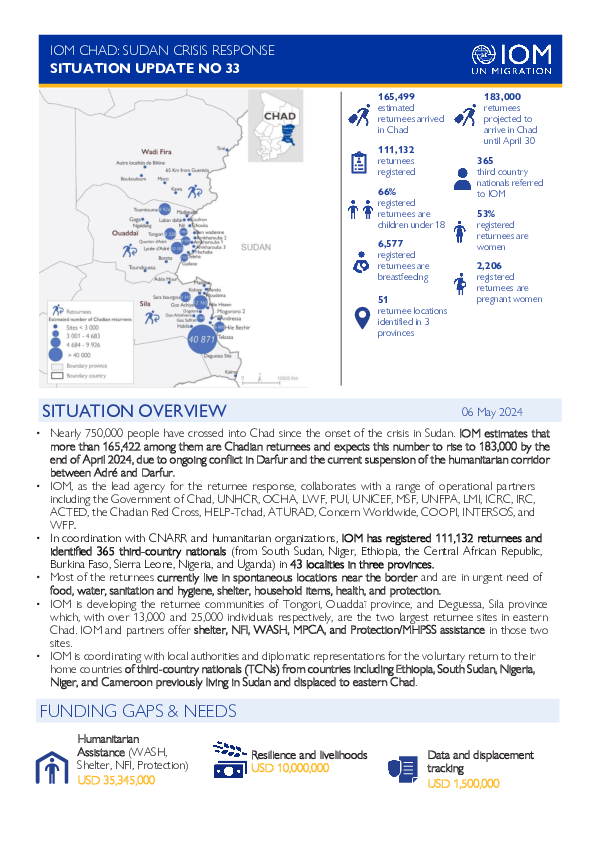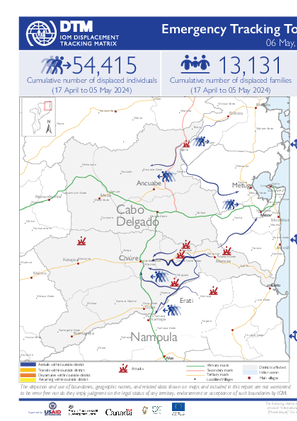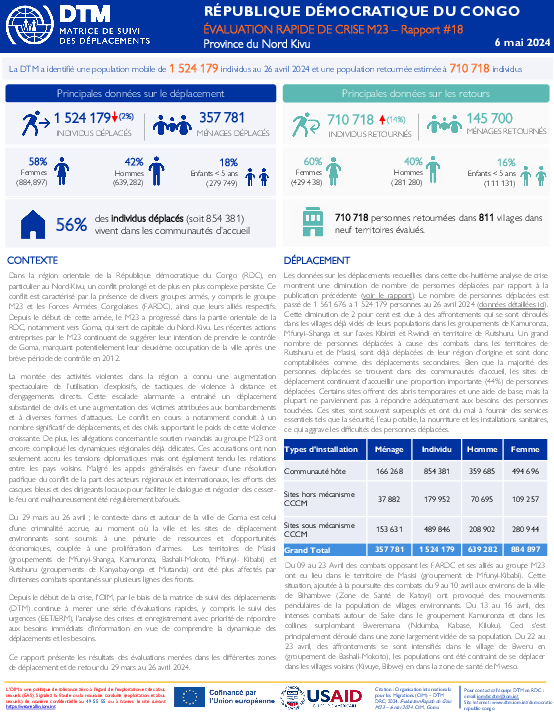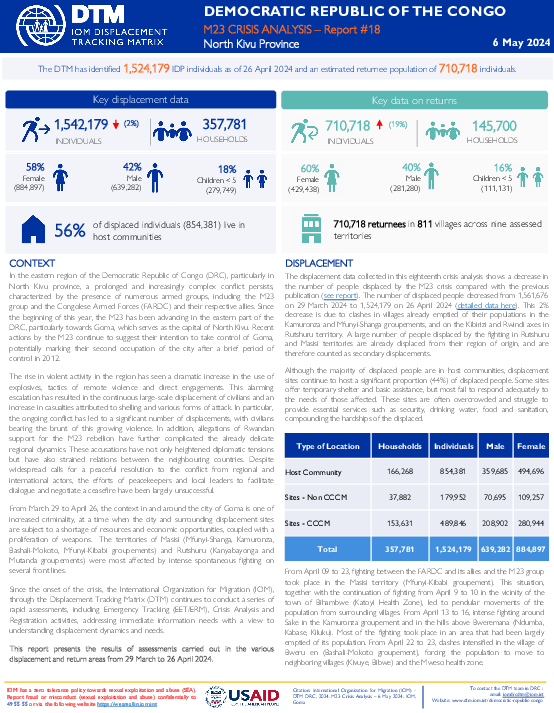-
Countries
-
Data and Analysis
-
Special Focus
-
Crisis Responses
• Overall exit movements from Ethiopia increased by 18% in the last month, marking the highest number of movements tracked since 2018, and an increase of 1% compared with the previous highest figure reported in December 2023 (18,119).
• The number of movements leaving Ethiopia due to conflict, violence or persecution multiplied more than eightfold between February (84) and March (731), which may be attributed to clashes between the Fano militia and government forces. In fact, all movements tracked due to conflict, violence or persecution departed the Amhara region, from where one in ten was looking for safety.
• Returns to Obock and Tadjourah decreased by 32% in the last month. This may be linked with the period of Ramadan, where the number of patrolling authorities in Yemen decreases and crackdowns on movements toward Saudi Arabia generally easen.
• The number of women (+9%) and children (+72%) tracked in Bossaso increased by more than a quarter (+27%). This increase was acute in girls, which more than doubled (+166%, from 121 to 322), while the number of boys increased by 44% (from 397 to 570).
• More than 400 migrants (385 Ethiopian, 25 Yemeni, and 1 Somali) were deported from Oman to Yemen, while in Ta’iz Governorate, a truck heading towards the north of the country that was smuggling 109 Ethiopian migrants was intercepted at a security checkpoint.

Contact
DTM Chad, dtmtchad@iom.int
Language
English
Location
Chad
Snapshot Date
May 06 2024
Activity
- Mobility Tracking
- Event Tracking
• Nearly 750,000 people have crossed into Chad since the onset of the crisis in Sudan. IOM estimates that more than 165,422 among them are Chadian returnees and expects this number to rise to 183,000 by the end of April 2024, due to ongoing conflict in Darfur and the current suspension of the humanitarian corridor between Adré and Darfur.
• IOM, as the lead agency for the returnee response, collaborates with a range of operational partners including the Government of Chad, UNHCR, OCHA, LWF, PUI, UNICEF, MSF, UNFPA, LMI, ICRC, IRC, ACTED, the Chadian Red Cross, HELP-Tchad, ATURAD, Concern Worldwide, COOPI, INTERSOS, and WFP.
• In coordination with CNARR and humanitarian organizations, IOM has registered 111,132 returnees and identified 365 third-country nationals (from South Sudan, Niger, Ethiopia, the Central African Republic, Burkina Faso, Sierra Leone, Nigeria, and Uganda) in 43 localities in three provinces.
• Most of the returnees currently live in spontaneous locations near the border and are in urgent need of food, water, sanitation and hygiene, shelter, household items, health, and protection.
• IOM is developing the returnee communities of Tongori, Ouaddaï province, and Deguessa, Sila province which, with over 13,000 and 25,000 individuals respectively, are the two largest returnee sites in eastern Chad. IOM and partners offer shelter, NFI, WASH, MPCA, and Protection/MHPSS assistance in those two sites.
• IOM is coordinating with local authorities and diplomatic representations for the voluntary return to their home countries of third-country nationals (TCNs) from countries including Ethiopia, South Sudan, Nigeria, Niger, and Cameroon previously living in Sudan and displaced to eastern Chad.

Contact
dtmmozambique@iom.int
Language
English
Location
Mozambique
Period Covered
Apr 17 2024
May 05 2024
Activity
- Mobility Tracking
- Event Tracking
Between 17 April and 5 May 2024, sporadic attacks, and fear of attacks by Non-state Armed Groups in Ancuabe, Chiúre and Erati triggered the cumulative displacement of 54,415 individuals/13,131 families. The current Movement Alert #110 reports on most recent attacks in southern Cabo Delgado. For more information on displacements between February and March, please see {Emergency Tracking Online Dashboard}.
Ancuabe attack | 2,959 Individuals displaced (17 April - 5 May 2024): Within the reporting period, attacks, and the fear of attacks by Non-State Armed Groups in Ancuabe led to the displacement of 2,959 individuals.
Chiure attack | 51,012 Individuals displaced (17 April – 5 May 2024): Within the reporting period, attacks, and fear of attacks by Non-State Armed Groups in Chiúre led to the displacement of 51,012 individuals.
Erati attack | 49,031 Individuals displaced (17 April – 5 May 2024): Within the reporting period, attacks, and fear of attacks by Non-State Armed Groups in Erati led to the displacement of 444 individuals.

Contact
DTM DRC, iomdrcdtm@iom.int
Language
French
Location
Democratic Republic of the Congo
Period Covered
Mar 29 2024
Apr 26 2024
Activity
- Mobility Tracking
- Event Tracking
Dans la région orientale de la République démocratique du Congo (RDC), en particulier au Nord-Kivu, un conflit prolongé et de plus en plus complexe persiste. Ce conflit est caractérisé par la présence de divers groupes armés, y compris le groupe M23 et les Forces Armées Congolaises (FARDC), ainsi que leurs alliés respectifs. Depuis le début de cette année, le M23 a progressé dans la partie orientale de la RDC, notamment vers Goma, qui sert de capitale du Nord-Kivu. Les récentes actions entreprises par le M23 suggèrent leur intention de prendre le contrôle de Goma, marquant potentiellement leur deuxième occupation de la ville après une brève période de contrôle en 2012.
Depuis le début de la crise, l'OIM, par le biais de la matrice de suivi des déplacements (DTM) continue à mener une série d'évaluations rapides, y compris le suivi des urgences (EET/ERM), l'analyse des crises et enregistrement avec priorité de répondre aux besoins immédiats d'information en vue de comprendre la dynamique des déplacements et les besoins. Ce rapport présente les résultats des évaluations menées dans les différentes zones de déplacement et de retour du 29 mars au 26 avril 2024

Contact
DTM DRC, iomdrcdtm@iom.int
Language
English
Location
Democratic Republic of the Congo
Period Covered
Mar 29 2024
Apr 26 2024
Activity
- Mobility Tracking
- Event Tracking
In the eastern region of the Democratic Republic of Congo (DRC), particularly in North Kivu province, a prolonged and increasingly complex conflict persists, characterized by the presence of numerous armed groups, including the M23 group and the Congolese Armed Forces (FARDC) and their respective allies. Since the beginning of this year, the M23 has been advancing in the eastern part of the DRC, particularly towards Goma, which serves as the capital of North Kivu. Recent actions by the M23 suggest their intention to take control of Goma, potentially marking their second occupation of the city after a brief period of control in 2012.
Since the onset of the crisis, the International Organization for Migration (IOM), through the Displacement Tracking Matrix (DTM) continues to conduct a series of rapid assessments, including Emergency Tracking (EET/ERM), Crisis Analysis and
Registration activities, addressing immediate information needs with a view to understanding displacement dynamics and needs. This report presents the results of assessments carried out in the various displacement and return areas from 29 March to 26 April 2024

Contact
dtmsupport@iom.int
Language
English
Location
Global
Period Covered
Jan 01 2022
Dec 31 2023
Activity
- Survey
- Flow Monitoring Survey
- Flow Monitoring
The COVID-19 pandemic marked an unprecedented shock to human mobility, shuttering borders and restricting movements in ways not seen in our lifetime. This report reflects the first attempt to assess how human movements has changed in the wake of this seismic event, by analysing Flow Monitoring data from the International Organization for Migration that surveys migrants at formal and informal border crossings. This report sketches how movements have fully recovered from pandemic-era restrictions and how they are being shaped by climate and displacement shocks through seven cases studies that cover a wide range of migrant destinations. This report is the third in a three-part series on the impact of COVID-19 on human mobility.
Contact
DTMDRC@iom.int
Location
Democratic Republic of the Congo
Activity
- Mobility Tracking
- Baseline Assessment
Period Covered
Mar 29 2024 -Apr 26 2024
The displacement data collected in this eighteenth crisis analysis shows a decrease in the number of people displaced by the M23 crisis compared with the previous publication (see report). The number of displaced people decreased from 1,561,676 on 29 March 2024 to 1,524,179 on 26 April 2024 (detailed data here). This 2% decrease is due to clashes in villages already emptied of their populations in the Kamuronza and Mfunyi-Shanga groupements, and on the Kibirizi and Rwindi axes in Rutshuru territory. A large number of people displaced by the fighting in Rutshuru and Masisi territories are already displaced from their region of origin, and are therefore counted as secondary displacements.
Population Groups
IDPs
Returnee (Previously Internally Displaced)
Survey Methodology
Unit of Analysis Or Observation
Admin Area 2
Admin Area 3
Admin Area 4
Type of Survey or Assessment
Key Informant
Keywords
Geographical Scope
Administrative boundaries with available data
The current dataset covers the following administrative boundaries

Contact
DTM Libya, DTMLibya@iom.int
Language
English
Location
Libya
Snapshot Date
Apr 30 2024
Activity
- Other
- Survey
- Flow Monitoring Survey
The findings of this study confirm that lacking travel documents is a contributing and exacerbating factor driving vulnerability among migrants in Libya. The data points to migrants’ experiences including whether they are able to obtain a work permit or a passport being strongly influenced by a range of factors including the conditions in the country of origin (e.g. ease of access to government-recognised ID), migration drivers (e.g. war and conflict hindering migrants’ ability to obtain the necessary travel documents), migration intentions (e.g. those who do not intend to stay in Libya are less likely to possess a travel documents) and means of transportation used to reach Libya (e.g. those having traveled by air are more likely to possess travel documents).
Overall, nine in ten migrants interviewed by DTM in November and December 2023 in Libya were without a work permit. Moreover, nearly two thirds of migrants did not possess a passport, a key precondition in obtaining a work permit.
Contact
DTM Yemen, iomyemendtm@iom.int
Location
Yemen
Activity
- Mobility Tracking
- Event Tracking
Period Covered
Apr 28 2024 -May 04 2024
From 1 January to 4 May 2024, IOM Yemen DTM tracked 1,159 households (HH) (6,954 Individuals) who experienced displacement at least once.
Between 28 April and 4 May 2024, IOM Yemen DTM tracked 32 households (192 individuals) displaced at least once. The majority of people moved into/within the following governorates and districts:
- Ma’rib (25 HHs) – Ma’rib (13 HHs), Ma’rib City (10 HHs), Harib (2 HHs) districts. Most displacements in the governorate originated from Ta’iz and Ma’rib.
- Ta’iz (6 HHs) – Jabal Habashi (5 HHs), Salah (1 HH) districts. All displacements in the governorate were internal.
- Ad Dali (1 HH) – Ad Dali (1 HH) district. All displacements in the governorate were internal.
The majority of people moved from the following governorates and districts:
- Ta’iz (11 HH) – Al Maafer (5 HHs), Al Misrakh (4 HHs), Salah (1 HH) districts.
- Ma’rib (5 HH) – Harib (2 HHs), Jabal Murad (2 HHs), Rahabah (1 HH) districts.
- Dhamar (3 HH) – Otmah (2 HHs), Dawran Anis (1 HH) districts.
Population Groups
Survey Methodology
Unit of Analysis Or Observation
Type of Survey or Assessment
Keywords
Geographical Scope
Administrative boundaries with available data
The current dataset covers the following administrative boundaries

Contact
DTM Yemen, iomyemendtm@iom.int
Language
English
Location
Yemen
Period Covered
Apr 28 2024
May 04 2024
Activity
- Displacement Solutions
- Mobility Tracking
- Event Tracking
IOM Yemen DTM’s Rapid Displacement Tracking (RDT) tool collects data on estimated numbers of households forced to flee on a daily basis from their locations of origin or displacement, allowing for regular reporting of new displacements in terms of estimated numbers, geography, and needs. It also tracks returnees who returned to their location of origin.
From 1 January to 4 May 2024, IOM Yemen DTM tracked 1,159 households (HH) (6,954 Individuals) who experienced displacement at least once.
Between 28 April and 4 May 2024, IOM Yemen DTM tracked 32 households (192 individuals) displaced at least once. The majority of people moved into/within the following governorates and districts:
- Ma’rib (25 HHs) – Ma’rib (13 HHs), Ma’rib City (10 HHs), Harib (2 HHs) districts. Most displacements in the governorate originated from Ta’iz and Ma’rib.
- Ta’iz (6 HHs) – Jabal Habashi (5 HHs), Salah (1 HH) districts. All displacements in the governorate were internal.
- Ad Dali (1 HH) – Ad Dali (1 HH) district. All displacements in the governorate were internal.
The majority of people moved from the following governorates and districts:
- Ta’iz (11 HH) – Al Maafer (5 HHs), Al Misrakh (4 HHs), Salah (1 HH) districts.
- Ma’rib (5 HH) – Harib (2 HHs), Jabal Murad (2 HHs), Rahabah (1 HH) districts.
- Dhamar (3 HH) – Otmah (2 HHs), Dawran Anis (1 HH) districts.
IOM identified 56 additional households displaced in the previous reporting period, which covered 21 - 27 April 2024, in the governorates of Al Hodeidah (29 HHs), Ta’iz (16 HHs), Ma’rib (9 HHs), and Ad Dali (2 HHs). These figures have been added to the cumulative displacement total recorded since the beginning of the year.
